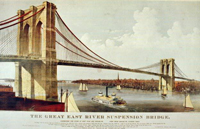Meet The King Of NY Con Men
November 25, 2007
New York Post
 New York City has been home to some of the cleverest con men in history – but no flimflam artist was a greater scoundrel than George C. Parker.
New York City has been home to some of the cleverest con men in history – but no flimflam artist was a greater scoundrel than George C. Parker.
In his upcoming book, The Modern Con Man: How to Get Something for Nothing, Todd Robbins recounts the astounding chutzpah of Parker as he merrily ripped off countless numbers of residents and tourists – “selling” them city landmarks over and over again.
“He was one of the ballsiest grifters ever,” Robbins writes. “He sold the Brooklyn Bridge on an average of twice a week for years and it was not unusual for buyers to begin construction of their own tollbooths before police broke the news to them.”
Following this great tradition, Joey Skaggs once sold the Brooklyn Bridge too (see The Brooklyn Bridge Lottery hoax). In 1992, he faked an inter-office memo from then Mayor David Dinkins, purporting that the City was planning a lottery to sell the Brooklyn Bridge. In addition to a million dollar prize, the winner would have the bridge named after him or her for five years. The proceeds would help to pay for the restoration of the decaying bridge.
To continue the Post story about George C. Parker:
Parker also made a fortune from suckers by selling the old Madison Square Garden over and over again. “He prepared like hell for these sales, going so far as to set up phony offices and fake documents to prove his ‘legal ownership,’ ” according to Robbins.
Continuing his successful scamming, Parker then “sold” both the Metropolitan Museum of Art and the Statue of Liberty. But perhaps his most outlandish transaction involved Grant’s Tomb, for which he posed as the legendary general and president’s grandson to seal the deal.
Alas, Parker’s con games eventually caught up to him and he was convicted of fraud three times, the third of which landed him an eight-year sentence at Sing Sing.
He died behind bars in 1936. But his legacy lives on in the famous American slogan, “If you believe that, then I have a bridge to sell you,” which is based on his cons.
Parker was actually not the first huckster to sell the Brooklyn Bridge, which opened in 1883. That distinction goes to a schemer named Peaches O’Day, who in 1899 collected $200 from one gullible citizen who received for his cash a bill of sale reading, “One bridge in good condition.”
Robbins notes the city’s nickname of “Gotham,” bestowed on the Big Apple by Washington Irving, has its roots in flimflammery. He writes that Gotham was originally the name of a small community in England that was regarded as a village of idiots in the Middle Ages. However, many believed that residents only pretended to be fools in order to con others and avoid paying taxes to the king.
image: Brooklyn Bridge, New York, Currier & Ives print of 1877. Library of Congress Prints and Photographs Division, reproduction number: LC-USZC2-3409
